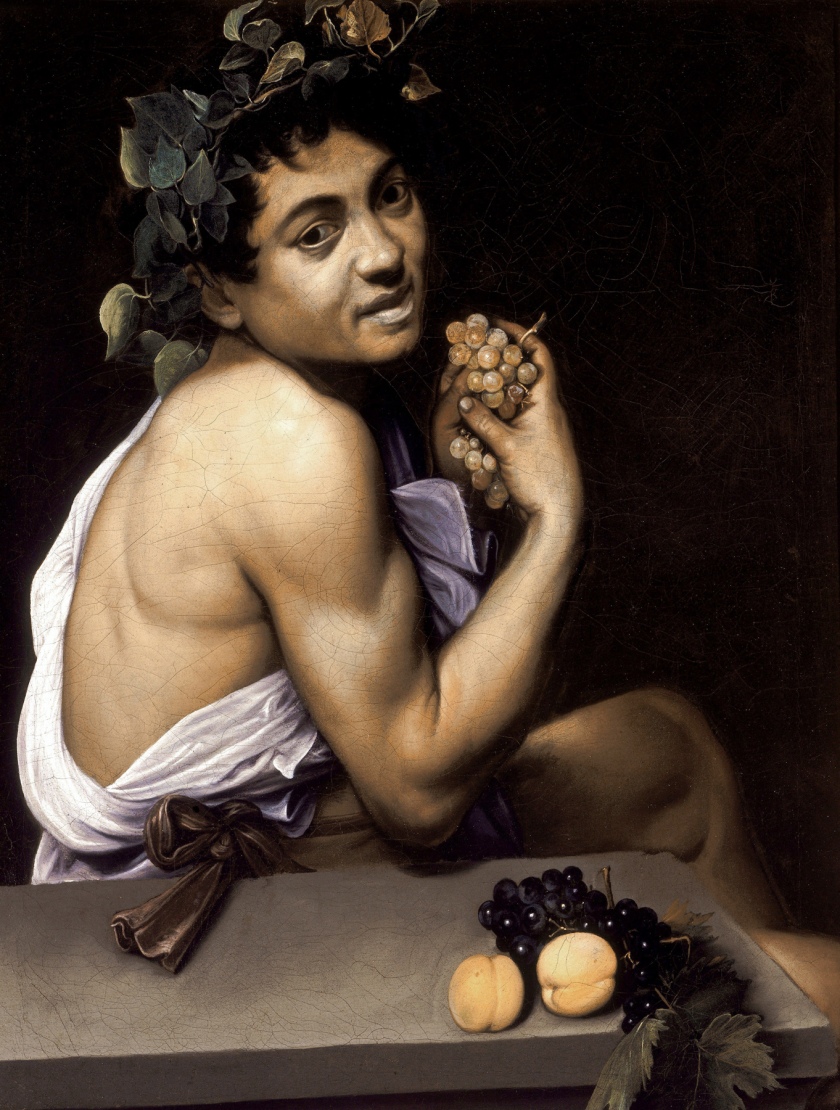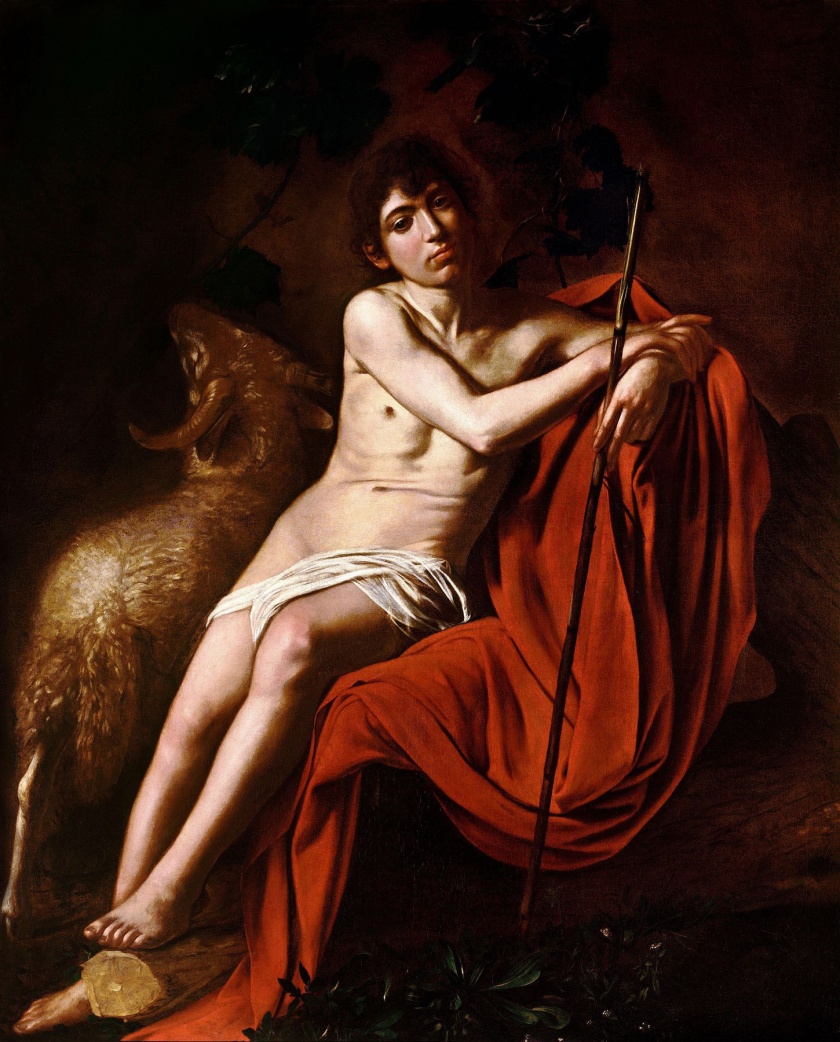2nd October 2009 – 24th January 2010
Michelangelo Merisi da Caravaggio (Italian, 1571-1610)
David with the Head of Goliath
c. 1610
Oil on canvas
125 cm × 101cm (49 in × 40 in)
Two of my favourite artists together for the first time!
Individually they are dazzling but the curatorial nous to bring these two great painters together – fantastic.
Imagine going back to the time of Caravaggio – his paintings in the churches of the powerful (not the rich, see, because the rich can never enter the kingdom of heaven) – lit by candlelight, all huge thrusting buttocks at eye level as you enter, the rich velvety colours, the drama, the dirty feet, the voluptuous forms stretched across the canvas.
Now imagine taking Bacon back to the same period. His sinuous, tortured bodies lit by candlelight – no a single electric light bulb (remember!) – innards spreading effusively, effluently along the floor. Can you imagine the gloomy interiors with Bacon’s figures looming out of the darkness? His Head VI screaming in the darkness …
Instinctively, intellectually we know how the paintings of a Baroque artist of the early 17th century affect how we look at the paintings of Bacon. This exhibition offers the reverse, in fact it rewrites how we look at Caravaggio – through the benediction of Bacon. Those rough house homosexuals sure knew a thing or two about painting, flesh, desire and the eroticism of the human body. God bless em!
PS. I have arranged the paintings below to illustrate some of the confluences and divergences between the two great artists, hopefully much as the actual exhibition will have done.
Dr Marcus Bunyan
.
Many thankx to the Gallery Borghese for allowing me to publish the art work in the posting. Please click on the photographs for a larger version of the image.
Michelangelo Merisi da Caravaggio (Italian, 1571-1610)
The Conversion of Saint Paul
c. 1600-1601
Oil on canvas
Francis Bacon (British, 1909-1992)
Study of George Dyer
1969
Oil on canvas
Michelangelo Merisi da Caravaggio (Italian, 1571-1610)
Saint John the Baptist in the Wilderness
1604
Oil on canvas
“I have always aspired to express myself in the most direct and crudest way possible, and maybe, if something is transmitted directly, people find it horrifying. Because, if you say something in the most direct way to a person, the latter sometimes takes offence, even if what you said is a fact. Because people tend to take offence at facts, or at what was once called truth.” ~ Francis Baon
This is how the Irish genius Francis Bacon justified his modus operandi, his propensity for a disquieting and sometimes grotesque distortion of the form. His works, placed next to those of another “damned” painter of the history of art, the great Caravaggio, will be exhibited from 1st October 2009 to 24th January 2010 at the Galleria Borghese in Rome. On the occasion of the fourth centenary of Caravaggio’s death, and of the centenary of Bacon’s birth, the figures of these eccentric artists, who are considered excessive – each one in their own way in their own period – are interweaved and narrated for the first time at the Galleria Borghese, which will also have prestigious loans from the most important museums in the world. By Caravaggio, already familiar with the Galleria Borghese thanks to his relation with cardinal Scipione Borghese, six masterpieces will be on view, synthesising his entire production: Boy with basket of fruit, Sick little Bacchus, Madonna and Child with St. Anne (dei Palafrenieri), David with the head of Goliath, Saint Jerome writing and Saint John the Baptist. Other key works of his artistic career will be added to these pieces of the permanent collection: Peter’s denial (Metropolitan in New York), Saul’s fall (Santa Maria del Popolo in Rome), The Martyrdom of St. Orsola (Palazzo Zevallos Stigliano in Naples) and the Portrait of Antonio Martelli, Knight of Malta (Palazzo Pitti). About twenty works by Bacon, loaned by the most prestigious museums, will be placed next to Caravaggio’s masterpieces.
The exhibition has the objective, with an unusual style and combining for the first time the two authors, not so much to immerse visitors in a historical-critical reconstruction, as much as to suggest an alternative aesthetic experience generated by the confrontation between the two expressive idioms which are so far yet so close. To tell the truth, the comparison between the two artists betrays Bacon’s grammar, as he did not love to be measured against the great masters of the past, even with those he esteemed the most: he ingeniously looked at the great “pillars” of the history of art filtering them through photography, which convulsively stimulated his perception and guided his creativity, until he conceived works that were very far from their original source of inspiration. Yet Caravaggio and Francis Bacon have something in common: in their linguistic, formal and temporal diversity they are both undisputed paladins of the human figure, they were able to seize the arcane undertones of life and art, and translate them into representations of ruthless frankness. Through the truth of flesh, what emerges are existential anxieties and a careful analysis of the human soul. In Caravaggio it happens thanks to his realism taken to obsession, in which the rigorous plasticity of bodies and theatrical illumination do not reveal only pleasant and harmonious shapes, they do not spare the spectators’ eyes from the crudeness of the distressing and deformed aspect of a subject. For Bacon physical deformation is enslaved to the ferocious narration of the human condition. Therefore, the password of this “strange couple” of artists is “truth,” of purposes and/or of means.
Therefore, the true stars of the exhibition are the spectators, it is up to them to contemplate the works and find links and discrepancies between the two artists, according to their own sensibility and regardless of the conditions originally foreseen by the painters for their creations. Those pieces live, in the museum context of Villa Borghese, an autonomous existence, free from their first generated status. The exhibition “Caravaggio – Bacon” is curated by Anna Coliva, Director of the Galleria Borghese, Claudio Strinati, Special Superintendent for the PSAE and for the Museum Pole of the city of Rome and by Michael Peppiatt, biographer and close friend who knew very well Francis Bacon, organised by MondoMostre and made possible thanks to the support of BG Italia, ENEL and Vodafone.
Press release from the Gallery Borghese website [Online] Cited 12/12/2009 no longer available online
Michelangelo Merisi da Caravaggio (Italian, 1571-1610)
Saint Jerome Writing
c. 1605-1606
Oil on canvas
112 × 157cm (44 in × 62 in)
Michelangelo Merisi da Caravaggio (Italian, 1571-1610)
Young Sick Bacchus
c. 1593
Oil on canvas
67 × 53cm (26 in × 21 in)
Michelangelo Merisi da Caravaggio (Italian, 1571-1610)
John the Baptist (John in the Wilderness)
c. 1610
Oil on canvas
159 × 124cm (63 in × 49 in)
Francis Bacon (British, 1909-1992)
Triptych in Memory of George Dyer
1971
Oil on canvas
Francis Bacon (British, 1909-1992)
Central panel of the Triptych in Memory of George Dyer
1971
Oil on canvas
Francis Bacon (British, 1909-1992)
Right panel of the Triptych in Memory of George Dyer
1971
Oil on canvas
Francis Bacon (British, 1909-1992)
Triptych
August 1972
Oil on canvas
Michelangelo Merisi da Caravaggio (Italian, 1571-1610)
The Denial of Saint Peter
1610
Oil on canvas
94 × 125.4cm (37 in × 49.4 in)
Francis Bacon (British, 1909-1992)
Triptych of George Dyer
1973
Oil on canvas
Francis Bacon (British, 1909-1992)
Central panel of the Triptych of George Dyer
1973
Oil on canvas
Francis Bacon (British, 1909-1992)
Head VI
1949
Oil on canvas
Michelangelo Merisi da Caravaggio (Italian, 1571-1610)
Boy with a Basket of Fruit
c. 1593-1594
Oil on canvas
70 × 67cm (28 in × 26 in)
Michelangelo Merisi da Caravaggio (Italian, 1571-1610)
Madonna and Child with St. Anne (dei Palafrenieri)
1606
Oil on canvas
292 × 211cm (115 in × 83 in)
Michelangelo Merisi da Caravaggio (Italian, 1571-1610)
The portrait of Antonio Martelli, Knight of Malta
1608-1609
Oil on canvas
118.5 × 95.5cm (46.7 in × 37.6 in)
Galleria Borghese
Piazzale Scipione Borghese, 5
Opening hours:
Tuesday – Sunday 9.00am – 5.00pm



















You must be logged in to post a comment.